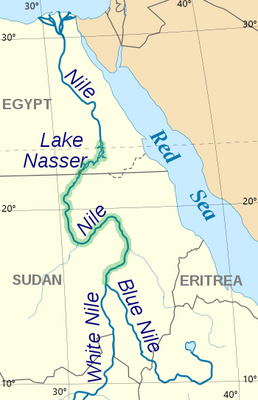
Back Nubië Afrikaans النوبة Arabic بلاد النوبه ARZ Nubia AST Nubiya Azerbaijani Нубія Byelorussian Нубія BE-X-OLD Нубия Bulgarian নুবিয়া Bengali/Bangla Nubia Breton
Nubia (/ˈnjuːbiə/) (Nobiin: Nobīn,[2] Arabic: النُوبَة, romanized: an-Nūba) is a region along the Nile river encompassing the area between the first cataract of the Nile (south of Aswan in southern Egypt) and the confluence of the Blue and White Niles (in Khartoum in central Sudan), or more strictly, Al Dabbah.[3][4][5][6] It was the seat of one of the earliest civilizations of ancient Africa, the Kerma culture, which lasted from around 2500 BC until its conquest by the New Kingdom of Egypt under Pharaoh Thutmose I around 1500 BC, whose heirs ruled most of Nubia for the next 400 years. Nubia was home to several empires, most prominently the Kingdom of Kush, which conquered Egypt in the eighth century BC during the reign of Piye and ruled the country as its 25th Dynasty (to be replaced a century later by the native Egyptian 26th Dynasty).
From the 3rd century BC to 3rd century AD, northern Nubia would be invaded and annexed to Egypt, ruled by the Greeks and Romans. This territory was known in the Greco-Roman world as Dodekaschoinos.
Kush's collapse in the fourth century AD was preceded by an invasion from the Ethiopian Kingdom of Aksum and the rise of three Christian kingdoms: Nobatia, Makuria and Alodia. Makuria and Alodia lasted for roughly a millennium. Their eventual decline started not only the partition of Nubia, which was split into the northern half conquered by the Ottomans and the southern half by the Sennar sultanate, in the sixteenth century, but also a rapid Islamization and partial Arabization of the Nubian people. Nubia was reunited with the Khedivate of Egypt in the nineteenth century. Today, the region of Nubia is split between Egypt and Sudan.
The primarily archaeological science dealing with ancient Nubia is called Nubiology.
| Part of a series on |
| History of Nubia |
|---|
 |
|
|
- ^ Elshazly, Hesham. "Kerma and the royal cache".
- ^ Reinisch, Leo (1879). Die Nuba-Sprache. Wien. p. 271.
{{cite book}}: CS1 maint: location missing publisher (link) - ^ Appiah, Anthony; Gates, Henry Louis (2005). Africana: The Encyclopedia of the African and African American Experience. Oxford University Press. ISBN 978-0-19-517055-9.
- ^ Janice Kamrin; Adela Oppenheim. "The Land of Nubia". www.metmuseum.org. Retrieved 2020-07-31.
- ^ "SudanHistory.org".
- ^ Raue, Dietrich (2019-06-04). Handbook of Ancient Nubia. Walter de Gruyter GmbH & Co KG. ISBN 978-3-11-042038-8.

